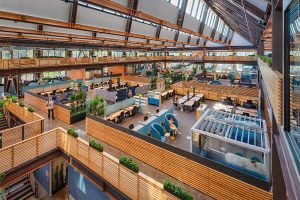Google opened its first ground-up mass timber (MTC) commercial office in Sunnyvale, Calif. in 2023 as part of the company’s objective to operate on carbon-free energy by 2030. The 180,000-square-foot LEED Platinum project was recognized in 2024 with the “Wood in Architecture” award by the non-profit organisation WoodWorks.
The design team of Michael Green Architects of Vancouver and SERA Architects of Seattle chose MTC both as a carbon reduction strategy and to create a warm, welcoming workspace environment. A big visual feature is the four-storey atrium with a massive skylight, exposed glulam beams and columns and CLT panels.
Also noteworthy is the closed-cavity wooden Venetian blind facade system, the first of its kind in North America. The blinds deploy, rotate and retract automatically throughout the day as the sun moves across the sky. This maximizes outward views and the occupants’ connection to the outdoors with minimal glare, while reducing energy use. The blinds themselves are made from Accoya, a modified radiata pine that is durable, stable, resistant to rot and decay, and therefore ideal for outdoor applications.
SERA Design explained the team’s objective to reduce carbon by at least 75 per cent from baseline.
“A Life Cycle Analysis indicated the project achieves a 47 per cent reduction in Global Warming Potential (GWP) compared with an equivalent steel building. When carbon sequestration is included, the project demonstrates a 96 per cent reduction in GWP.”

Since Sunnyvale is in a seismically sensitive area, certain engineering considerations were required. Structural Engineers Equilibrium Consulting used the CLT floor panels to act as a horizontal diaphragm in combination with large buckling-restrained steel braced frames. Positioning this steel frame within the mass timber gravity system meant that the steel carried no gravity load.
Google’s building is striking in its exterior appearance as well.
A series of 14-foot cantilevered floor plates were made from a wood-concrete composite. The lightweight composite system reduced the required depth of the concrete beams and slabs connecting the CLT panels, thereby covering outdoor seating areas while allowing light into the interior.
Google is not the only major technology company that is building with wood to reduce carbons. Microsoft has two data centres planned for Virginia. Each will use a hybrid of CLT and steel-concrete as part of their goal to become carbon negative, water positive, zero waste and more protective of land by 2030.
Renderings of Microsoft’s two data centres unveiled last October indicate typical rectilinear structures, with cut-out openings, expansive glazing and wood-clad exteriors. Microsoft says incorporating mass timber and CLT into their designs will, “reduce the embodied carbon footprint of two new data centres by 35 per cent compared to conventional steel construction, and 65 per cent compared to typical precast concrete.”
Microsoft hopes this latest initiative might serve as models for their future data centres, already numbering about 300 worldwide.
“Our goal is by trialling materials such as CLT in our data centres, we will encourage innovation and be a catalyst for inspiring adoption within the datacentre industry and beyond.”
A degree of skepticism has been expressed concerning the actual impact of the use of carbon-reduced building materials and operations by technology giants like Google and Microsoft.
It makes great headlines, however, massive energy users like data centres may be engaging in a form of what environmental commentator Lloyd Alter calls “greenwrapping.” He goes on to say, “The life cycle carbon emissions saved by going with timber might be little more than a rounding error.”
According to the U.S. Department of Energy, the power load growth of data centres is projected to double or triple by 2028, many times more per square foot than typical commercial buildings. Bloomberg reports Google’s operations alone warm the planet 48 times faster today than in 2019.
To be fair, however, MTC is only part of overall corporate carbon-reduction plans. Something is better than nothing. However, given the growth of new data centres alongside that of AI, energy use is destined to become a serious issue. Google’s and Microsoft’s actual environmental achievements will be closely watched.
John Bleasby is a freelance writer. Send comments and Inside Innovation column ideas to editor@dailycommercialnews.com.




Recent Comments